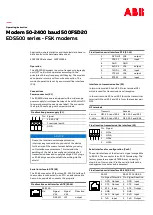
Configure network interfaces
Configure Advanced interfaces settings: External modems and PPP
Digi TransPort WR Routers User Guide
292
Configure Advanced interfaces settings: External modems and
PPP
The
Configuration > Network > Interfaces > Advanced
menu has the following sub-menu options:
▪
External Modems
▪
PPP Mappings
▪
PPP
n
Point-to-Point Protocol (PPP) is a standard protocol for transporting data from point to multipoint
networks (such as IP) across point-to-point links (such as a serial or ISDN connection). This
functionality is essential for dial-up Internet access.
As data is transferred across IP networks in synchronous format, the router supports asynchronous
to synchronous PPP conversion. This allows asynchronous terminals connected to the routers to
communicate with remote synchronous PPP devices. Normally, this is carried out using a single
ISDN B-channel so that data can be transferred at speeds up to
64
Kbps. This is known as ASYNC to
SYNC PPP operation and is supported as standard by most terminal adapters. To use ASYNC to
SYNC PPP operation all that is necessary is to ensure that the PPP protocol is bound to the ASY port
to which the terminal or PC is connected. (see
Configuration > Network > Interfaces > Serial
).
Note
To use ASYNC to SYNC PPP, the attached terminal must also support PPP (Windows dial-up
networking supports PPP).
In addition to ASYNC to SYNC operation (where the router only converts the PPP from one form to
another) the router can initiate its own PPP sessions. For example, the router uses this operation
when:
▪
The router is configured as a router to connect an Ethernet network to the Internet via ISDN or
W-WAN.
▪
The router is answering an incoming ISDN call with PPP either for remote management or
remote access to the Ethernet network to which the router is connected.
▪
The router is accessed locally through the serial port for configuration purposes by setting up a
Windows Dial-Up-Networking connection to the phone number
123
.
Note
Except for MLPPP, the parameters in this section are only relevant when the router is
generating the PPP. They are not relevant for ASYNC to SYNC PPP operation.
The router also supports Multi-link PPP (MLPPP). MLPPP uses both ISDN B-channels simultaneously
(and two PPP instances), to provide data transfer speeds up to
128
Kbps for applications such as
email or establishing a point-to-point connection between two routers.
Содержание TransPort WR11
Страница 1: ...User Guide Digi TransPort WR Routers ...
Страница 215: ...Configure network interfaces Configure mobile cellular interfaces Digi TransPort WR Routers User Guide 215 ...
Страница 650: ...Configure system settings NTP parameters Digi TransPort WR Routers User Guide 650 ...
Страница 661: ...Configure system settings General system parameters Digi TransPort WR Routers User Guide 661 ...
Страница 662: ...Configure system settings General system parameters Digi TransPort WR Routers User Guide 662 ...
Страница 663: ...Configure system settings General system parameters Digi TransPort WR Routers User Guide 663 ...
Страница 682: ...Configure Remote Management SNMP parameters Digi TransPort WR Routers User Guide 679 ...
Страница 683: ...Configure Remote Management SNMP parameters Digi TransPort WR Routers User Guide 680 ...
Страница 813: ...Manage networks and connections Top Talkers Digi TransPort WR Routers User Guide 808 ...
Страница 814: ...Manage networks and connections Top Talkers Digi TransPort WR Routers User Guide 809 ...
Страница 815: ...Manage networks and connections Top Talkers Digi TransPort WR Routers User Guide 810 ...
Страница 816: ...Manage networks and connections Top Talkers Digi TransPort WR Routers User Guide 811 ...
Страница 817: ...Manage networks and connections Top Talkers Digi TransPort WR Routers User Guide 812 ...
Страница 818: ...Manage networks and connections Top Talkers Digi TransPort WR Routers User Guide 813 ...
Страница 855: ...Device administration Reboot the router Digi TransPort WR Routers User Guide 844 ...
















































